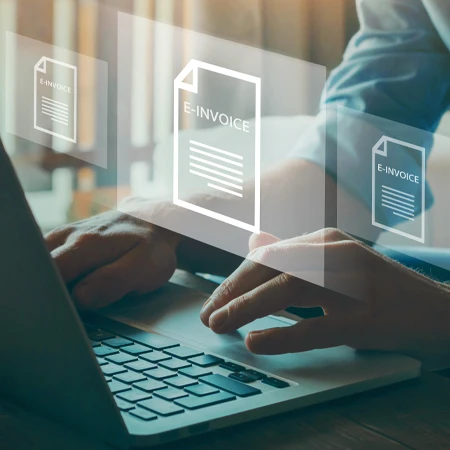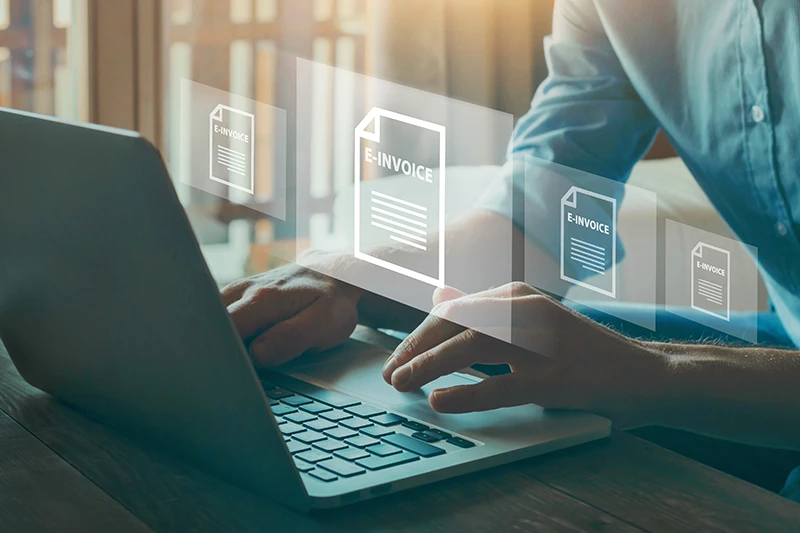E-Invoicing: The Digital Ally Every Legal Firm Needs (And Why Hiding Cash is Like Hiding an Elephant)

E-Invoicing: The Digital Ally Every Legal Firm Needs (And Why Hiding Cash is Like Hiding an Elephant)
In today’s fast-paced world, e-invoicing has become a game-changer for legal firms. Not only does it streamline billing processes, but it also enhances compliance and transparency, making it mandatory for even client accounts. Let’s explore how e-invoicing impacts legal practices, with a touch of humour and some practical examples.
The Benefits of E-Invoicing
Enhanced Accuracy and Efficiency: E-invoicing automates the billing process, reducing human errors and ensuring that invoices are accurate and timely. No more deciphering your colleague’s messy handwriting! This efficiency allows legal professionals to focus on important legal work instead of administrative tasks.
Improved Cash Flow: E-invoicing speeds up the billing cycle, ensuring that payments are received faster. This boost to cash flow is crucial for the financial health of any legal firm. Imagine not having to chase clients for payments like a dog chasing its tail!
Transparency and Client Satisfaction: Clients benefit from the clarity of electronic invoices. They can review and pay invoices easily, fostering trust and strengthening client relationships. It’s like giving them a clear map instead of a treasure hunt.
Regulatory Compliance: E-invoicing systems often come with built-in compliance features that help legal firms adhere to regulations. This reduces the risk of non-compliance and ensures peace of mind. Think of it as having a digital watchdog that never sleeps.
Challenges in Implementing E-Invoicing
Technological Compatibility: Integrating e-invoicing systems with existing software can be challenging. Ensuring compatibility and seamless data transfer requires patience and creativity.
Stakeholder Resistance: Some staff may resist the change due to unfamiliarity with new technology. Effective training and communication are essential to overcome this resistance. Remember, even the most stubborn mule can be led to water with the right carrot.
Data Security: Protecting sensitive client and financial data is crucial. Robust cybersecurity measures must be implemented to guard against cyber threats. Think of it as building a digital moat around your castle.
Cost of Implementation: The initial cost of setting up e-invoicing systems can be high, but the long-term benefits often outweigh these expenses. It’s like investing in a high-quality coffee machine—expensive upfront, but worth it for the endless supply of caffeine.
Steps to Implement E-Invoicing
- Evaluate Current Processes: Assess existing billing processes to identify areas for improvement and potential challenges.
- Choose the Right Software: Select e-invoicing software that integrates well with your current systems and meets your firm’s specific needs.
- Training and Support: Provide comprehensive training for staff to ensure they are comfortable using the new system. Ongoing support is crucial to address any issues that arise.
- Pilot Testing: Implement the e-invoicing system on a small scale first to identify and resolve any issues before a full rollout.
- Monitor and Adjust: Continuously monitor the system’s performance and make necessary adjustments to improve efficiency and compliance.
Client Account Compliance: A Noble Endeavour
Managing client accounts, especially trust accounts, is a critical aspect of legal practice. Here are some key points on compliance:
- Segregation of Funds: Legal firms must keep client funds separate from their own operating funds. Mixing these funds can lead to serious ethical and legal issues. It’s like mixing your laundry—keep the whites and colours separate!
- Accurate Record-Keeping: Firms must maintain detailed records of all transactions involving client funds. This includes documenting deposits, withdrawals, and any interest earned. Think of it as keeping a diary, but for money.
- Interest Allocation: Any interest earned on client funds must be calculated and allocated appropriately, ensuring clients receive their fair share. It’s like splitting a pizza-everyone gets their due slice.
- Regular Audits: Conducting regular audits of client accounts helps ensure compliance with regulatory standards and identifies any discrepancies early. Consider it a financial health check-up.
- Use of Technology: Implementing trust accounting software can streamline the management of client accounts, reduce administrative burdens, and enhance accuracy. It’s like having a personal assistant who never takes a day off.
How E-Invoicing Helps Catch Money Laundering in Legal Firms
E-invoicing is a powerful tool that enhances transparency and accuracy in financial transactions, making it much harder for illegal activities like money laundering to go undetected. Here’s how e-invoicing can help catch money laundering and prevent tax evasion in legal firms:
Hiding Income: E-invoicing creates a digital trail for every transaction, making it much harder to hide illicit funds. Each invoice is recorded and can be easily audited, ensuring that all income is accounted for and reported accurately. This transparency makes it difficult for firms to disguise illegal income as legitimate.
Creating False Expenses: E-invoicing systems require detailed documentation for each transaction, including the nature of the expense and the parties involved. This level of detail makes it challenging to fabricate expenses without detection. Auditors can quickly spot inconsistencies and verify the legitimacy of claimed expenses, reducing the risk of false reporting.
Avoiding Detection: The digital nature of e-invoicing means that every transaction is recorded in a structured format, making it easier to track and analyse. Advanced analytics and automated monitoring tools can detect unusual patterns and flag suspicious activities. This makes it much harder for firms to use layering techniques to obscure the origins of illicit funds.
Penalties for Non-Compliance with the Inland Revenue of Malaysia
Legal firms in Malaysia must adhere to strict regulations set by the Inland Revenue Board of Malaysia (IRBM). Non-compliance can lead to severe penalties, including fines and imprisonment:
- Failure to Furnish an Income Tax Return: A fine between RM200 and RM20,000 and/or imprisonment up to 6 months (Section 112(1) of the Income Tax Act 1967).
- Submitting Incorrect Tax Returns: A fine between RM1,000 and RM10,000 plus 200% of the tax undercharged (Section 113(1)(a) of the Income Tax Act 1967).
- Wilful Tax Evasion: A fine between RM1,000 and RM20,000 and/or imprisonment up to 3 years plus 300% of the tax undercharged (Section 114(1) of the Income Tax Act 1967).
- Failure to Issue E-Invoices: A fine ranging from RM200 to RM20,000 or imprisonment for up to 6 months, or both, for each instance of non-compliance (Section 120(1) of the Income Tax Act 1967).
Proforma Invoices vs. E-Invoices
Proforma Invoices: These are preliminary, non-binding documents that provide an estimate of the goods or services to be delivered, their prices, and other details. They are often used to request payment in advance but are not considered final or legally binding. Companies may not accept such proforma invoices as they are not recognised. Using them can be misconstrued as an attempt at tax evasion or delaying income. Especially in a system that relies on e-invoicing, Inland Revenue or Customs may interpret this as intentional misconduct. In the future, don’t be surprised if even banks request e-invoices for large transactions to conclude.
E-Invoices: These are final, legally binding documents issued after goods or services have been delivered. They include all transaction details, such as the final price, payment terms, and due date. For compliance purposes, only e-invoices are valid as they provide a clear and auditable record of the transaction.
Income on Accrual Basis for E-Invoices
Accrual accounting records revenue and expenses when they are earned or incurred, not when cash is exchanged. This method provides a more accurate picture of a firm’s financial health:
Recording Income: With e-invoicing, income is recorded when the service is provided or the goods are delivered, not when payment is received. This ensures that financial statements reflect the true economic activity of the firm.
End of Camouflaging Cash Income: E-invoicing makes it difficult to camouflage cash income as accrual transactions. Every transaction is digitally recorded and can be easily audited, ensuring transparency and compliance.
A Lighthearted Warning to Stubborn Lawyers
To the esteemed members of the legal profession who might be a tad stubborn about embracing e-invoicing and accrual accounting:
Imagine trying to hide cash income in the age of e-invoicing. It’s like trying to hide an elephant behind a curtain-everyone can see it! Every transaction you make is digitally recorded, leaving a trail as clear as day. So, if you’re thinking of sticking to old tricks, beware! The “Tax Authorities” are coming, and they have magnifying glasses.
Remember, the law is meant to be read as it is written, not as you wish it to be. Trying to outsmart the system is like playing chess with a computer-you’re bound to lose. Embrace the change and let e-invoicing and accrual accounting guide you to a more transparent and compliant practice.
As the venerable Justice Oliver Wendell Holmes Jr. once remarked, “The life of the law has not been logic; it has been experience.” And let us not forget the wisdom of Justice Thurgood Marshall: “The court’s authority stems from the respect accorded to its judgments.”
In conclusion, embracing e-invoicing and maintaining diligent client account compliance will serve legal firms well in this modern age. May your practices flourish, and may justice be ever served.
For a deeper dive into how e-invoicing can transform your practice, get in touch with us. We’re here to help you unlock new efficiencies and ensure compliance-one e-invoice at a time.
“Redefining the Art of Tax”


